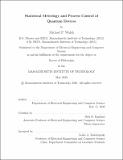| dc.contributor.advisor | Dirk R. Englund. | en_US |
| dc.contributor.author | Walsh, Michael P.,Ph. D.Massachusetts Institute of Technology. | en_US |
| dc.contributor.other | Massachusetts Institute of Technology. Department of Electrical Engineering and Computer Science. | en_US |
| dc.date.accessioned | 2020-09-03T17:41:09Z | |
| dc.date.available | 2020-09-03T17:41:09Z | |
| dc.date.copyright | 2020 | en_US |
| dc.date.issued | 2020 | en_US |
| dc.identifier.uri | https://hdl.handle.net/1721.1/126998 | |
| dc.description | Thesis: Ph. D., Massachusetts Institute of Technology, Department of Electrical Engineering and Computer Science, May, 2020 | en_US |
| dc.description | Cataloged from the official PDF of thesis. | en_US |
| dc.description | Includes bibliographical references (pages 169-187). | en_US |
| dc.description.abstract | Quantum emitters, such as color centers (e.g., nitrogen-vacancy color centers in diamond), have a wide range of applications in quantum information processing, bioimaging, and quantum sensing. Such quantum emitters are typically addressed optically and store their quantum state as an electron spin that can subsequently be read out optically. For this process to work effectively, an efficient light-matter interaction must be achieved, which is difficult given the small interaction cross section of an atomic memory with the optical field. In this thesis, I address three problems that relate to the engineering of a quantum device. The first problem centers on the fact that most quantum emitters are randomly positioned throughout their host lattice making it difficult to lithographically pattern structures intended to increase the light-matter interaction. While there is a non-zero chance that a small number of randomly aligned structures will coincide with randomly positioned emitters, when efforts to scale such a system are made the yield drops exponentially. The second problem has to do with scaling. As systems scale up to larger sets of interacting qubits, it becomes increasingly necessary to produce quantum emitters with narrow optical transitions and long spin coherence times. The third problem is related to the development of tools to manage experiments and data in a more robust, team-centric, and structured manner. The automation of systems to measure qubits and devices that enables improvement of each step in the design process will be crucial if efforts to scale devices beyond a handful of qubits are to be successful. Here, I will review the progress that I made in each of these areas. | en_US |
| dc.description.statementofresponsibility | by Michael P. Walsh. | en_US |
| dc.format.extent | 187 pages | en_US |
| dc.language.iso | eng | en_US |
| dc.publisher | Massachusetts Institute of Technology | en_US |
| dc.rights | MIT theses may be protected by copyright. Please reuse MIT thesis content according to the MIT Libraries Permissions Policy, which is available through the URL provided. | en_US |
| dc.rights.uri | http://dspace.mit.edu/handle/1721.1/7582 | en_US |
| dc.subject | Electrical Engineering and Computer Science. | en_US |
| dc.title | Statistical metrology and process control of quantum devices | en_US |
| dc.type | Thesis | en_US |
| dc.description.degree | Ph. D. | en_US |
| dc.contributor.department | Massachusetts Institute of Technology. Department of Electrical Engineering and Computer Science | en_US |
| dc.identifier.oclc | 1191226934 | en_US |
| dc.description.collection | Ph.D. Massachusetts Institute of Technology, Department of Electrical Engineering and Computer Science | en_US |
| dspace.imported | 2020-09-03T17:41:09Z | en_US |
| mit.thesis.degree | Doctoral | en_US |
| mit.thesis.department | EECS | en_US |
